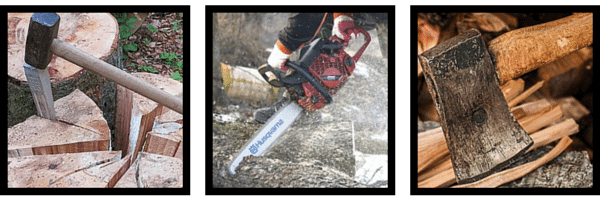When people think about splitting logs, they often imagine a plaid-shirted, bearded woodsman bringing an ax down on a hunk of wood; over and over and over again.

Most people wince at the very thought of that kind of backbreaking labor. These days, there are plenty of solutions out there that make splitting logs a bit less labor-intensive. A log splitter is a great tool to have if you’re constantly cutting firewood or even if you just need something that’ll give your back a rest.
The good news is that there are a lot of options to choose from and the bad news is that there are a lot of options to choose from. So, finding the perfect log splitter for your needs is going to take a bit of effort on your part, but at least it’ll be a painless sort of effort… and you get to sit the whole time!
We’ve gone ahead and hammered out a few details about the basic “styles” you’ll have to consider before you start looking into the bells and whistles that come with your new log splitter.
Horizontal vs. Vertical
First, you have to decide whether to purchase a horizontal log splitter or a vertical log splitter.
Vertical log splitters are safer to use on uneven terrain and accommodate a variety of log sizes. However, you will have to balance logs up on an end for a vertical log splitter to operate.
Horizontal log splitters allow users to lay the logs on their side without needing to worry about balancing the log. However, horizontal log splitters are not ideal if you’re splitting larger logs.
If you’re looking for a residential log splitter, then something that is relatively light in weight and easier to transport may be a good choice. Many models can be fitted onto towing hitches or a towing package, that allows for transport via vehicle. Professional log splitter models can weigh hundreds of pounds, and in most cases they perform a much better job of cutting cord after cord of firewood.
Gas vs. Electric
The next thing you’ll need to decide is whether a gas log splitter or an electric log splitter will serve you best.
While both electric log splitters and gas log splitters require about the same amount of effort to operate - which is very little! - you shouldn’t choose one over the other arbitrarily. You’ll need to consider how much wood you plan on splitting and how often you’ll be splitting it.
Electric log splitters, also called “compact” log splitters, need to be connected to a power source. Conveniently, many smaller units only require 110-volts to run.
Electric log splitters will perform the best when used by the “causal” log splitter. The causal log splitter is someone enjoys having a nice supply of firewood on hand for cozy fires in the winter and fun campfires in the summer.
Typically, the casual wood splitter is in the 4-Ton to 10-Ton range. Don't be fooled by need for an outlet, however, because electric wood splitters also range in the 12-Ton to 20-Ton range, too!
Gas log splitters are equipped with a small gasoline motor that drives the hydraulics.
Gas log splitters are geared toward the “serious” log splitter. The serious log splitter is someone who is going to be splitting multiple cords, season after season, to utilize firewood as a regular fuel source or to sell - or both.
Typically, the serious wood splitter is in the 20-Ton to 22-Ton range or the 24-Ton to 28-Ton range, depending on whether or not denser hardwoods are being used or number of cords that need to be split. On the extreme ends, you'll see gas wood splitters in the 8-Ton to 16-Ton and 30+ tonnage range.
Once you’ve decided which orientation and power source will best meet your needs you’ll be able to start looking into the fun things like flame decals and accessories.
